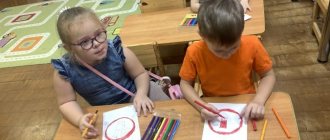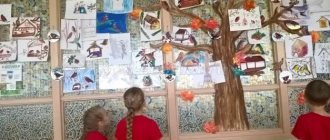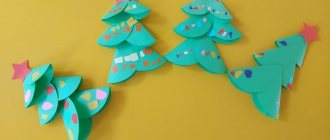Presentation on the topic: Age-related features of the development of preschool childrenpresentation on the topic
Slide 1
The presentation was prepared by the teacher-psychologist of the MBDOU “Child Development Center - Kindergarten No. 65 “Ivushka” in Almetyevsk Zhuravleva A.Yu.
Slide 2
Early age (2-3 years) The emergence of active speech Formation of visual-figurative thinking Assimilation of objective actions Perception is involuntary Setting goals in games and behavior Receptive to the emotional state of others The main features of a child 2-3 years old are openness, honesty and sincerity.
Slide 3
Recommendations for the development of young children Stimulate the child's statements Develop fine motor skills of the hands to activate speech (finger games, drawing, modeling, games with cereals, etc.) Maintain a clear daily routine Use self-learning toys (matryoshka dolls, inserts, pyramids) Introduce children through games color spectrum, standards of shapes (basic geometric shapes)
Slide 4
Crisis (gr. krisis decision, turning point, outcome) - a sharp, abrupt turning point, a difficult transitional state.
Slide 5
Age crisis Age crisis is a normal state for every growing person. A crisis occurs at the junction of two ages and indicates the completion of one stage of development and the beginning of the next. During such periods, new needs appear and the child’s behavior changes.
Slide 6
Crisis stages in the development of children (in the classification of L.S. Vygotsky, a famous psychologist) - newborn crisis; — crisis 1 year; — crisis 3 years; — crisis 7 years; — teenage
Slide 7
Crisis of 3 years Passes under the slogan: “I myself!” The child’s self-esteem and self-awareness are born. Adults’ prohibitions are increasingly responded to with protest. In this way the child defends his rights. Play becomes the leading activity. The boundaries of what is permitted are checked.
Slide 8
Crisis of 3 years The child becomes interested in success or failure in business and games Reacts violently to the assessment of his affairs and actions, learns to independently evaluate the results of his activities Sensitivity and sensitivity to the feelings of other people
Slide 9
Time limits of the crisis “3-year crisis” is a conditional definition, since the time frame of the crisis is much wider. For some children it begins at 2 years 10 months, and for others at 3.5 years.
Slide 10
Tips for overcoming a 3-year-old crisis Personal space of a child (room, toys...) Compromises Daily routine A clear system of prohibitions. Changing the form of communication with the child Give the opportunity to be independent Treating the child as an equal
Slide 11
Peculiarities of development of children 4-5 years old Active expansion of horizons More physically resilient Fatigue decreases, the background of the mood is leveled, becomes more stable, less susceptible to changes Desire for partnership in games Inquisitiveness and curiosity are manifested Ability to draw conclusions Imagination is actively developing
Slide 12
At the age of 4-5 years, the shortcomings in raising a child begin to gradually take root and turn into stable negative character traits
Slide 13
Peculiarities of development of children 5-6 years old Actively explores the world around him, forms answers or creates versions himself Often attracts attention to himself Tests the strength of the boundaries set by other adults A mechanism for managing his behavior is emerging Desire to be like adults who are significant to him Gender differences are realized Fears may increase
Slide 14
Recommendations for the development of children 5-6 years old Respect his fantasies Support the child’s desire for positive self-expression Do not set a boundary that you are not able to defend and maintain Provide the opportunity to communicate with peers Reduce control and guardianship Be more willing to respond to requests for help than on duty and obligation
Slide 15
Features of the development of children 6-7 years old are able to realize their position in the system of relationships with adults and peers, strive to meet the requirements of adults, strive for achievements in the types of activities that they perform, interest in new types of activities, interest in the world of adults, the desire to be like them capable of volitional regulation of behavior (based on internal motivations and established rules) able to show persistence and overcome difficulties
Slide 16
Recommendations for the development of children 6-7 years old Encourage the child’s independence and activity, give him the opportunity to act independently Be close to the child, show that you understand and appreciate him, respect his achievements and can help in case of failure Encourage even the smallest success of the child along the way achieving the goal Be consistent in your requirements Set an example of “adult” behavior for your child. habits and ways of communication
Slide 17
Crisis of 7 years Associated with the child’s entry into school. The ability to withstand school loads, a new system of requirements, relationships. Study becomes the leading activity. Irritability. Fears, increased anxiety
Slide 18
Tips for overcoming the crisis of 7 years It is necessary to prepare the child for school in advance (educational games, memorizing poetry, modeling, drawing, graphic dictations) Encourage communication with peers Do not overload with additional activities Praise more for the finished result Teach constructively treats mistakes and failures Teach the child independently to complete tasks
Slide 19
Thank you for your attention!
What presentations are suitable for children of primary preschool age?
Maisat A.Z.
What presentations are suitable for children of primary preschool age?
MUNICIPAL BUDGET
PRESCHOOL EDUCATIONAL INSTITUTION
KINDERGARTEN No. 8 “THE LITTLE MERMAID”
Kstovo 3 microdistrict building 27 telephone 2-11-93, 2-27-16, 2-17-31
What presentations are suitable for young children??
Developed by the teacher:
Second Jr. groups,
Abdullaeva M.Z.
Kstovo
2020
Presentations for younger groups:
Let's look specifically at presentations for nursery groups ; the little ones are now taught this way too!
• 1 What is the essence of working with presentations ?
• 2 What presentations are suitable for young children??
2.1 By the way, I recommend reading:
• 3 My achievements from past years!
• 4 If you want to increase your child’s self-esteem, play with him!
• 5 Let me start educating myself!
What is the essence of working with presentations ?
of presentations during the school year , both for children and parents, which can be shown to them at a meeting. For example, I made a presentation on routine moments for young children . They really liked that the information was presented not only verbally, but also visually. This is also very convenient because such a presentation can then be sent to parents by email, and they will not have to sit and take notes with a pen instead of watching and listening.
As for the work of educators themselves, they must choose during the year a certain direction of the project in which they will work. Themes can be very different, but for the nursery group of a kindergarten it is better to choose light and interesting themes that will be appropriate for this age , for example, colors, animals, favorite toys, etc.
At the end of the school year, as a rule, in May, a final meeting is held in the kindergarten, during which the teacher tells parents about the successes of their children, and also talks about his activities over the past year. A nursery group report is prepared in advance, which also indicates the number of presentations on topics for students and their parents. The teacher can also introduce some data from the analytical report to parents.
If you are a good teacher, an attentive educator, but are completely far from these technical issues, including the use of ICT technologies, then you can find good ready-made options.
What presentations are suitable for young children??
In a nursery group, it is difficult to keep children’s for a long time on the same activity, and looking at a screen for a long time at this age is quite harmful , so the main rule of creating a presentation for kids is brevity, colorfulness and accessibility.
In other words, it should be short, bright and beautiful, and with its help the child should get acquainted with the information that this presentation carries and assimilate this information.
I offer an example of a colorful presentation on the topic “Wild Animals”
. It is relatively small, but at the same time voluminous in content: children get acquainted with wild animals that live not only in our area, but also in other regions and continents, and also learn short poems along the way.
Or here’s some interesting material about the most common colors for babies. The image of objects of a specific color will allow you to visually reinforce the material, and with the help of poems you can also perceive the information aurally. Usually this combination in training gives very good results.
As for the selection for parent meetings, I recommend paying attention to the methodological development “Adaptation of toddlers ”
, because more than half of the kids are faced with adapting to kindergarten, especially at such a young
age , and parents are most often at a loss and don’t know how to help the baby.
I hope that the information offered will be useful to you, my dear novice educators. I was glad to help you, and you can help your colleagues - share this article
Presentations for children, page 5
Materials found: 1,013 Displayed: 41 - 50
Direct educational activity “Safety rules for children on railway transport”
Direct educational activities on safety, senior and preparatory school groups, Topic: “Safety rules for children on railway transport” Goal: Teaching children the rules of safe behavior on…
Project “Our native land - Donskoy”
Type of project: short-term (1.5 months) Project participants: children of the preparatory group for school, teachers, parents. Explanatory note. Relevance of the project. Preschool childhood is an important stage in the formation of the appearance...
Didactic game on patriotic education “Enchanted Village” for older children
Didactic game “Enchanted Village” Explanatory note: The didactic game “Enchanted Village” is intended to enrich children’s knowledge and ideas about patriotic education. Used in educational…
Pedagogical project “What time tell me? Look at your watch!”
Pedagogical project “What time tell me? Look at the clock! » Type of project: long-term (October-April. Type of project: informational - research - creative Participants: students of the senior group, teachers of the senior...
Master class: “Innovative approaches to organizing experimental activities of children in kindergarten”
Tell me and I’ll forget, show me and I’ll remember, let me try and I’ll understand. Chinese proverb - Theatrical activity is very close to me, so I decided to show all the experiments in the form of a fairy tale, I think this is an effective method, because...
Methodological recommendations for working on the topic “Space exploration” with children 5–6 years old
This methodological development allows you to diversify the teacher’s competence in working with children in the field of cognitive development and in the field of artistic and aesthetic development. The author proposes to consolidate children's knowledge about space...
Pedagogical project “This is what it is, our summer” (for young children)
Completed by teachers: Zhivotyagina Elena Anatolyevna Ermakova Anastasia Valerievna Explanatory note A healthy baby is great! Everyone wants to see children healthy, strong and agile, cheerful and cheerful, resilient...
Pedagogical project “Our home is Russia”
Type of project: medium duration (March - May) Type of project: informational - creative Participants: pupils of the preparatory group, parents of pupils of the preparatory group, teaching staff of the preparatory group...
Using electronic interactive didactic multimedia aids in the educational process
Topic: “Orthodox holidays are glorious with their traditions” Age of target group: Senior preschool age. Purpose of the manual: Formation of primary ideas about the national culture of children of senior preschool age, familiarization...
Methodological development “Funny nesting dolls” Integrated lesson in the middle group
Goal: to form in children a cognitive interest in Russian folk culture through familiarization with the Russian folk toy - the nesting doll. Objectives: 1. Continue to enrich children’s understanding of folk art; introduce you to Russian...
Presentations for children - go to the main page of the section.
Pages: … 5 … 102
All sections






